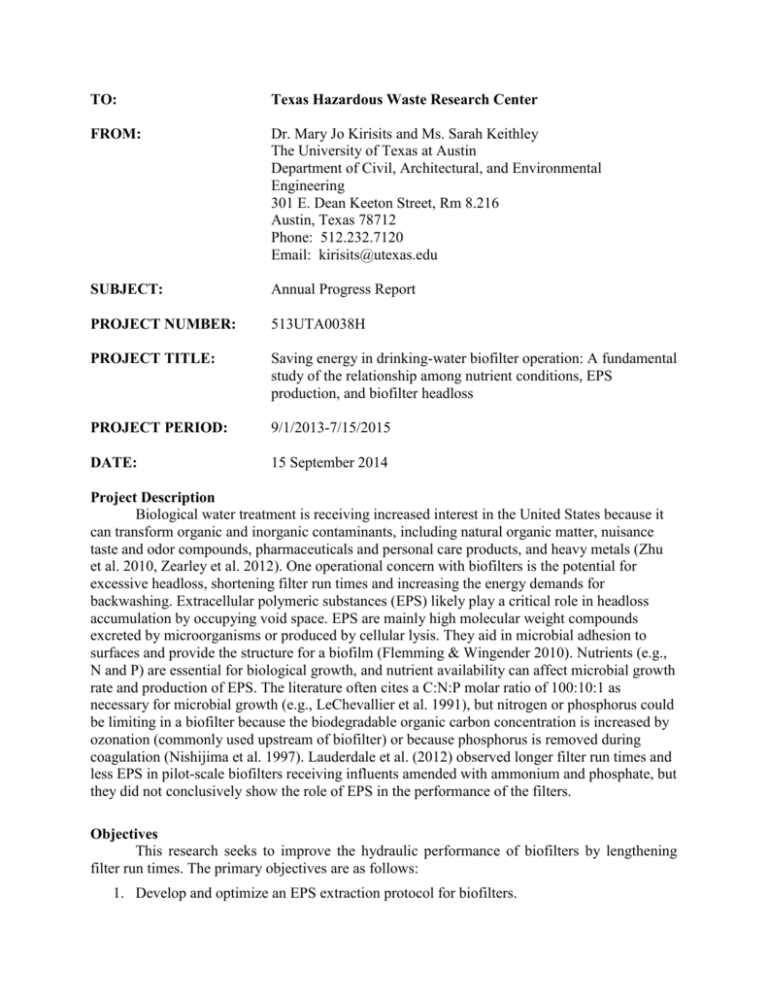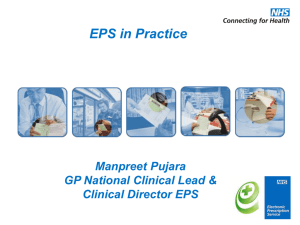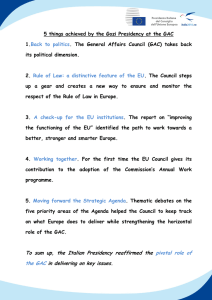TO: Texas Hazardous Waste Research Center FROM: Dr. Mary Jo
advertisement

TO: Texas Hazardous Waste Research Center FROM: Dr. Mary Jo Kirisits and Ms. Sarah Keithley The University of Texas at Austin Department of Civil, Architectural, and Environmental Engineering 301 E. Dean Keeton Street, Rm 8.216 Austin, Texas 78712 Phone: 512.232.7120 Email: kirisits@utexas.edu SUBJECT: Annual Progress Report PROJECT NUMBER: 513UTA0038H PROJECT TITLE: Saving energy in drinking-water biofilter operation: A fundamental study of the relationship among nutrient conditions, EPS production, and biofilter headloss PROJECT PERIOD: 9/1/2013-7/15/2015 DATE: 15 September 2014 Project Description Biological water treatment is receiving increased interest in the United States because it can transform organic and inorganic contaminants, including natural organic matter, nuisance taste and odor compounds, pharmaceuticals and personal care products, and heavy metals (Zhu et al. 2010, Zearley et al. 2012). One operational concern with biofilters is the potential for excessive headloss, shortening filter run times and increasing the energy demands for backwashing. Extracellular polymeric substances (EPS) likely play a critical role in headloss accumulation by occupying void space. EPS are mainly high molecular weight compounds excreted by microorganisms or produced by cellular lysis. They aid in microbial adhesion to surfaces and provide the structure for a biofilm (Flemming & Wingender 2010). Nutrients (e.g., N and P) are essential for biological growth, and nutrient availability can affect microbial growth rate and production of EPS. The literature often cites a C:N:P molar ratio of 100:10:1 as necessary for microbial growth (e.g., LeChevallier et al. 1991), but nitrogen or phosphorus could be limiting in a biofilter because the biodegradable organic carbon concentration is increased by ozonation (commonly used upstream of biofilter) or because phosphorus is removed during coagulation (Nishijima et al. 1997). Lauderdale et al. (2012) observed longer filter run times and less EPS in pilot-scale biofilters receiving influents amended with ammonium and phosphate, but they did not conclusively show the role of EPS in the performance of the filters. Objectives This research seeks to improve the hydraulic performance of biofilters by lengthening filter run times. The primary objectives are as follows: 1. Develop and optimize an EPS extraction protocol for biofilters. 2. Examine the relationship among C:N:P molar ratios, EPS concentrations, and headloss accumulation in bench-scale biofilters. 3. Fundamentally interrogate the activity of the microbial community by monitoring gene expression. Methodology This research is divided into three tasks, mapping to the three objectives. These are described in the following paragraphs. The first task involves testing a variety of EPS extraction protocols cited in the literature and choosing one for optimization. The optimized protocol will maximize the polysaccharide and protein concentrations while minimizing contamination from cell lysis. In general, EPS is extracted in triplicate by adding 2 ± 0.1 g granular activated carbon (GAC) to a 15-mL conical tube, followed by 10 mL of extraction buffer. Samples are incubated and then centrifuged at 15,000×g. The supernatant, containing the EPS, is filtered through a 0.45-m filter and transferred to a fresh 15-mL conical tube. Polysaccharides and proteins are quantified either immediately after extraction, or the extracts are stored at -20 °C overnight and analyzed the following day. The GAC is retained, dried at 105 °C, and weighed to measure the total solids (TS). Polysaccharides are quantified using a modified phenol-sulfuric acid method that is a scaled-up version of the protocol described by Masuko et al. (2005) with glucose as the standard. Proteins are quantified using a bicinchoninic (BCA) kit (Thermo Fisher Scientific, Rockford, IL) with bovine serum albumin (BSA) as the standard. Polysaccharide and protein concentrations are normalized to TS. The second task is to operate three bench-scale biofilters under different nutrient conditions: one balanced with respect to C:N:P, one nitrogen-limited, and one phosphoruslimited. Biofilter performance will be assessed by (i) monitoring headloss, (ii) measuring traditional water quality parameters (e.g., pH, dissolved organic carbon, ammonia, nitrate, and phosphate concentrations), and (iii) quantifying EPS concentrations on the filter media using the method developed in Task 1. The third task is to analyze the microbial community and monitor microbial activity in each filter via RNA sequencing and de novo metatranscriptome assembly. The microbial community will be identified by extracting DNA, sequencing the 16S rRNA gene, and analyzing the sequences using Quantitative Insights into Microbial Ecology (QIIME). Transcriptional activity will be assessed by extracting total RNA, purifying mRNA, using high-throughput shotgun sequencing to sequence all mRNA, and analyzing the sequences according the protocol described by Baker et al. (2013). Accomplishments/Problems Task 1 is near completion. Four extraction buffers were compared: 73 M formaldehyde, 73 M formaldehyde + 1 N NaOH, 10 mM Tris/EDTA + 2.5% NaCl pH 8, and 10 mM Tris/EDTA + 2.5% NaCl pH 11. Although previous studies (Liu & Fang 2002, Compte et al. 2006, Adav & Lee 2008) have reported formaldehyde buffers to be best for extracting EPS from wastewater sludge, we found that formaldehyde interferes with polysaccharide and protein quantification, and therefore it is not suitable for extracting EPS. Significantly more EPS was extracted using the Tris/EDTA + 2.5% NaCl pH 8 buffer as compared to the Tris/EDTA + 2.5% NaCl pH 11 (t-test, p<0.001). Preliminary results suggest that the Tris/EDTA + 2.5% NaCl pH 8 buffer also extracts more EPS than using a cation exchange resin (CER) in phosphate-buffered saline. Thus Tris/EDTA + 2.5% NaCl pH 8 appears to be the best EPS extraction buffer for GAC, so further optimization was conducted using it. Four parameters have been investigated for optimization: initial physical treatment, temperature, time, and shaking during incubation (Figure 1). Experiments were done using GAC from a full-scale biofilter in Tampa, Florida. One parameter was tested per day over four consecutive days. The base case, which consisted of inverting 10× by hand at the beginning, 22 °C, 4 h, and 0 rpm of shaking during incubation, was tested each day. All four parameters were found to significantly affect the EPS yield (1-way ANOVA, p<0.002), and the EPS yield increased with increasing temperature, time, and shaking. Our results suggest that the best method for extracting EPS from GAC is to use 10 mM Tris/EDTA + 2.5% NaCl pH 8, vortex for 1 min at the outset, and incubate at 35 °C for 8 h with shaking at 200 rpm. Figure 1. Optimizing EPS extraction with Tris/EDTA + 2.5% NaCl pH 8 by varying (A) initial physical treatment, (B) temperature, (C) time, and (D) shaking. Error bars show one standard deviation from triplicate extractions. It is possible that bacteria could produce EPS during the extraction, which might explain why EPS concentrations were higher after the 35 °C and 8-h extractions. To test this hypothesis, EPS extractions were done with either 0 or 20 mM sodium azide (NaN3), which suppresses microbial activity without lysing cells, at 4 or 8 h and 22 or 35 °C. Our results showed that the EPS concentration was slightly, but significantly, higher in extractions done with 20 mM NaN3 (3-way ANOVA, p<0.001). This result was unexpected, but the difference between the 0 mM and 20 mM NaN3 extractions decreased as the incubation temperature and time increased. There was a significant interaction between temperature and time (3-way ANOVA, p=0.003), which was expected but was not verifiable with the individual parameter tests. Our results indicate that bacteria do not produce EPS during the extraction, so EPS yields might be improved at 35 °C and 8 h for kinetic reasons. Task 2 has been started by constructing the bench-scale columns and designing the influent solutions. Three parallel trains of two columns in series will be operated. In each train, the first column has an inner-diameter of 2.5 cm, a bed depth of 15 cm, and a theoretical empty bed contact time (EBCT) of 8 min; it is the primary column that will be analyzed throughout the study. The second column has an inner-diameter of 4.8 cm and a bed depth of 5 cm. It will provide acclimated GAC to replace what is removed from the first column for analysis, so that the EBCT does not change. The columns were packed with 0.8-mm diameter GAC. The GAC was obtained from a full-scale biofilter in Arlington, Texas. It was dried, ground, sieved, and washed prior to being packed in the columns. The columns will be seeded with microorganisms from a full-scale biofilter. Salts & CO32- DDI H2O C, N, & P Stocks F1: Balanced C:N:P F2: N-limited F3: P-limited Figure 2. System set up, excluding the second column in each train. DDI: distilled deionized. The salts and carbonate buffer will be added to distilled deionized (DDI) water to simulate a groundwater (Li et al. 2010). A carbon stock simulating ozonated water will be used, consisting of 130 g/L formaldehyde, 39 g/L glyoxal, 520 g/L formate, and 390 g/L acetate, providing a biodegradable organic carbon concentration of 316 g/L. This carbon stock is a modified version of that used by Elhadi et al. (2006), with the ratio among the four carbon sources remaining the same, but the overall carbon concentration is higher so that the ammonia and phosphate concentrations would be above their detection limits in the balanced C:N:P case. Each train will be operated under a different nutrient condition: balanced, N-limited, or Plimited. All will be operated under the balanced nutrient condition during the start-up phase. Once the percent of DOC removal varies by less than 5% over the course of 2 weeks, the stringency of the nutrient limitation will be increased in the appropriate columns. Future Work To complete Task 1, the CER extraction method (commonly used for EPS in the literature) will be compared to the Tris/EDTA + 2.5% NaCl pH 8 method. Then the efficacy of the determined best method will be assessed qualitatively via staining and visual inspection using confocal scanning laser microscopy. GAC before and after EPS extraction will be stained using calcofluor white to stain β-linked polysaccharides, concanavalin A to stain α-linked polysaccharides, fluorescein isothiocyanate to stain amino residues, and SYTO 84 to stain nucleic acids (Chen et al. 2007). Finally, the extent of cell lysis will be determined by sterilizing a sample of GAC from a full-scale biofilter, adding a known concentration of Zoogloea sp. (Gram-negative) or Rhodococcus sp. (Gram-positive) to GAC, carrying out the EPS extraction, and measuring the concentration of viable bacteria after the extraction. Extractions from sterile GAC without the addition of Zoogloea sp. or Rhodococcus sp. will be done in parallel. The difference in the bacterial concentration before and after EPS extraction along with the difference in EPS yields between the sterile GAC with and without the addition of bacteria will be used to assess the extent of cell lysis. These three experiments will complete Task 1. The second half of the grant period will be spent on Tasks 2 and 3, operating the benchscale columns, assessing their performance, and interrogating the activity of the microbial communities. Publications and Presentations Building on the progress in year 1 of the project, a presentation and publication are in preparation. We intend to present a poster on the biofilters at the World Environmental and Water Resources Congress in Austin, Texas on May 17-21, 2015. We are currently writing a manuscript detailing the optimization of the EPS extraction protocol for GAC. References Adav, S.S., Lee, D.-J., 2008. J. Hazard. Mater. 154, 1120–6. Baker, B., Sheik, C., Taylor, C., Jain, S., Bhasi, A., Cavalcoli, J., Dick, G., 2013. ISME J. 7, 1962–1973. Comte, S., Guibaud, G., Baudu, M., 2006. Enzyme Microb. Technol. 38, 237–245. Elhadi, S.L.N., Huck, P.M., Slawson, R.M., 2006. J. Am. Water Works Assoc. 98, 108–119. Flemming, H.-C., Wingender, J., 2010. Nat. Rev. Microbiol. 8, 623–33. Lauderdale, C., Chadik, P., Kirisits, M.J., Brown, J., 2012. J. Am. Water Works Assoc. 104, 298– 309. LeChevallier, M.W., Schulz, W., Lee, R.G., 1991. Appl. Environ. Microbiol. 57, 857–62. Li, X., Upadhyaya, G., Yuen, W., Brown, J., Morgenroth, E., Raskin, L., 2010. Appl. Environ. Microbiol. 76, 7473–81. Liu, H., Fang, H.H.P., 2002. J. Biotechnol. 95, 249–56. Masuko, T., Minami, A., Iwasaki, N., Majima, T., Nishimura, S.-I., Lee, Y.C., 2005. Anal. Biochem. 339, 69–72. Nishijima, W., Shoto, E., Okada, M., 1997. Water Sci. Technol. 36, 251–257. Zearley, T.L., Summers, R.S., 2012. Environ. Sci. Technol. 46, 9412–9. Zhu, I.X., Getting, T., Bruce, D., 2010. J. Am. Water Works Assoc. 102, 67–77.






